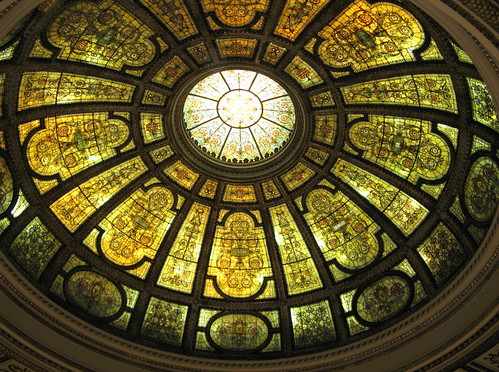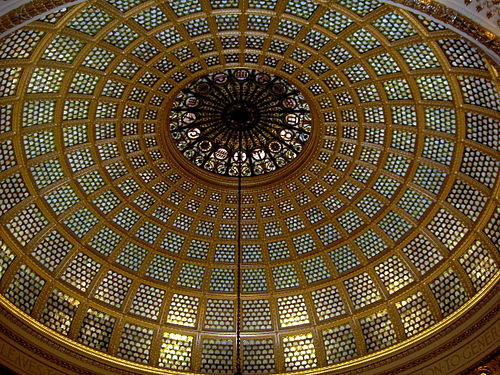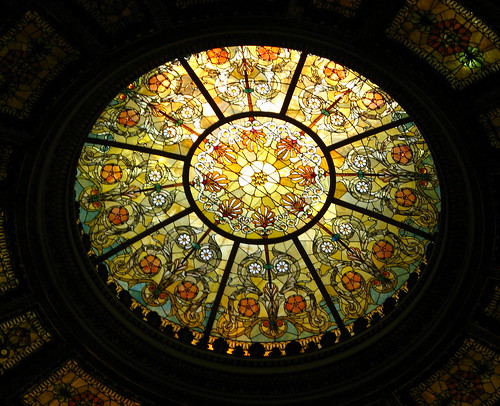The names Healy and Millet likely will never be as well-known as Tiffany. But to those who look up at two stained-glass ceilings in the building that housed Chicago’s grand first central public library, George Healy and Louis Millet created an artwork that is dazzling, like Louis Tiffany’s, in that “can’t take my eyes off of it” way. Of course, the Tiffany stained-glass ceiling – which the Chicago Cultural Center proclaims is the largest Tiffany dome in the world – has drawn all kinds of acclaim and attention. The Healy-Millet ceiling not so much, but it is hardly the “other dome.”
It’s almost mind-blowing that two such domes are in one building. They are in the Chicago Cultural Center, a place in the Loop of high energy and community where you’ll find in any given hour an exhibit in one room, a singer next door, an art opening in another area, meetings elsewhere, folks reading and relaxing, and much more. This is set amid a building that is a spectacular artwork in itself.
The City of Chicago constructed this palatial building on East Washington Street and opened it in 1897, at a time when many cities sought to outdo each other and boost their prestige and reputation by constructing the grandest public places. The city government converted the structure into an arts and culture center, once Chicago’s central library moved to a new home in the Loop in 1991. “Be sure to see the Tiffany dome,” a friendly security guard said as I walked through the entrance during a recent trip to Chicago, and he provided directions. Luckily, I took a wrong turn at the top of a stairwell and came into the Grand Army of the Republic hall where the Healy-Millet stained-glass ceiling is, or I may never have seen it. What a sight.

The Healy-Millet ceiling, Chicago Cultural Center
The Healy-Millet dome is both a marvel and a fascinating story. It is a wonder of light, color, and pattern, and it’s very worth spending some time in its presence. Furthermore, the building and the dome reflect not only beauty and amazing artistry but history, telling of a city’s resurgence after a devastating fire two decades before and its desire to create a magnificent library for all of its people and a worthy place to honor Union veterans from the Civil War. Today, the stained-glass domes personify the continuing vision of some that it matters to restore and preserve such creations to their original dazzling form.
Seeing the Victorian splendor of the Healy-Millet dome brings to mind its beginnings and what led to the building of this “people’s palace,” as it became known. The Chicago public library arose directly out of the devastation of Chicago’s Great Fire in 1871, which killed some 250 people and burned four square miles of the city’s center. The fire destroyed thousands of books in the Chicago Lyceum’s public reading room. In the fire’s aftermath, a Londoner proposed that the English should donate a library-full of books to Chicago as a token of sympathy and kindness. Soon afterward, Chicago received approximately 8,000 books from England, which sparked leading Chicago citizens to begin a movement that culminated in the establishment of the Chicago Public Library.
A Chicagoan’s Library
It would be years before this trove of books and the thousands added to it would find a real home. Finally, after the city moved the library from location to location for more than two decades, the Library Board chose Dearborn Park to construct a permanent home. However, a sort of turf war erupted. The state legislature had donated part of this park to a Civil War veterans’ association. Ultimately, an agreement specified that the building would encompass two purposes: a new Chicago Public Library and a Grand Army of the Republic (GAR) Memorial Hall honoring the Northern soldiers who had fought in the Civil War. The Healy-Millet dome resides in the former GAR rotunda.
Today, many buildings and wings of libraries come about through the largesse of the wealthy, and this was also true in the late 19th century. Rather than look for philanthropic donations to fund the building, however, the city levied a special 1 percent tax on its citizens, so that it could be said that the library, indeed, belonged to everyone, according to the Chicago Cultural Center’s history of the library.

Chicago Cultural Center (Photo Credit: David K. Staub)

The Tiffany ceiling, Chicago Cultural Center
With the Great Fire as recent memory, Chicago sought to construct a library that would not only wow the public but endure for the ages as a solid, practically incombustible building. Its exterior had Greek columns and Roman arches, and its structure included three-foot thick masonry walls faced with limestone. For nearly a year, some 70 men drove nearly 2,400 wooden piles, on which the foundation rests, to an average depth of 74 feet into the hardened clay below the area’s sandy soil. Its interior includes marble from Italy, Ireland, and elsewhere; mosaics of Favrile glass; polished brass; and mother-of-pearl.
Then there were the great domes atop its beautiful halls, the Tiffany and the Healy-Millet ceilings, each of intricately assembled stained glass. On the Washington Street side, the Tiffany Glass and Decorating Company fashioned the library’s stained-glass ceiling. It is huge, at 38 feet in diameter, and contains 30,000 pieces of glass. The dome sat above the library’s circulation delivery desk, with natural light that poured through its opulent fish-scale pattern of jeweled glass, creating perhaps a sense of a sacred space honoring books and literature. I can picture the library’s earliest patrons, eagerly receiving their books with the flow of light above.
Similarly, on the north side, the Healy-Millet dome within the Grand Army of the Republic rotunda conveys a sense of hallowed space and stateliness. At 40 feet in diameter, it’s glorious in color, with varied earth tones including reddish-orange, deep gold, corn yellow, green, and brown, in a Renaissance pattern of botanical motifs. It’s so alive that I felt like I was seeing changing patterns of plants and other nature forms, all as one’s eyes move around the dome. It’s mesmerizing.

The oculus, or circular window, of the Healy-Millet ceiling
Two masters of art glass design and manufacturing, Millet and Healy were responsible for this ceiling. Millet, educated at the École des Beaux Arts in Paris, founded the Chicago School of Architecture in 1893 and was a force within the Arts and Crafts movement in Chicago, according to a profile in the Chicago Sun-Times. He and Healy created some of the most memorable, innovative interior design and art glass in Chicago in the decades after the Great Fire. Both worked with architect Louis Sullivan at various times and became renowned in the United States and Europe for their work.
Let the Sun Shine
Yet their work and that of Tiffany’s company on the library were almost lost for the generations to come. For a time in the early 1970s, Chicago officials considered whether to keep or demolish the building. Ultimately, they decided to save it. Furthermore, as beautiful as both of the stained-glass ceilings are, thousands passed under them for many decades without being able to see just how colorful and fabulous they are. Sometime in the 1940s, the Healy-Millet dome was roofed over and stunning daylight gave way to artificial light. This all but deadened its vibrant colors. During the decade before, the library had also replaced the outer translucent dome on the Tiffany ceiling with a concrete copper-clad covering, lighting the ceiling artificially.
Thankfully, this all changed in recent years. Through a pilot restoration project in the middle of the past decade, several companies worked together to restore the Healy-Millet dome, refinish its ornamental cast iron frame, and re-establish a diffusing skylight above the ceiling to bring back natural daylight. “The restored glass is sure to shock and awe anyone who walks into this space and has grown accustomed to the muted, somber tone of the covered portions of the dome,” wrote Neal Vogel of Restoric, LLC, one of those who executed the restoration.
The Tiffany has had its own piece-by-piece-by-piece re-emergence into brilliant light after some 75 years. Starting in 2007, the restoration team removed each art glass panel and painstakingly numbered all 30,000 pieces of glass. Botti Studio, located in Evanston, Ill., cleaned each one and repaired those in need of it (more than 1,800 pieces were cracked). Finishing up a seven-month restoration, workers replaced the copper-concrete covering with an energy-efficient translucent one. Now, those who walk through the Preston Bradley Hall can see the Tiffany ceiling in bright and shimmering colors, the way that Tiffany & Co. designed it and how the crowds saw it in 1897.
And if they are lucky, they will take the correct turns to see the Healy-Millet ceiling, too.



I thought of you while in Stockholm the past few weeks when I passed a particularly beautiful or unusual building or part thereof . I wondered to myself what would Susan write about if she saw this. I took lots of photos and will share the link once they’re all downloaded.
Maureen,
There must have been many beautiful buildings in Stockholm, and I’m curious about the similarities and the differences you noticed compared with New York. How great of you to tell me that I came to mind then!
I’ll look forward to a link once you download your photos — then I can feel that I vicariously went there (which I hope to do sometime).
Hope that you had a marvelous time!
Susan
What a fascinating history for a building that is likely taken for granted. I love the generosity of the English, donating books to replace the ones lost in the fire. And dare I say the Healy-Millet dome looks more impressive and colorful than the Tiffany dome? Your photos are gorgeous.
I give tours with the Chicago Trolley and Double Decker Bus Company and can’t praise the Cultural Center’s domes enough to visitors on my tours.
Our downtown buildings rival those of any others in America in design, features, and histories .
Sincerely,
John
John,
How great for you to leave this comment, coming from one who obviously never takes this beauty, history, and richness for granted. I can only imagine the responses of so many on your tours as they see those ceilings.
In my book, Chicago is one of the top American cities – perhaps the best – in its treasure of architectural history and beauty in that space of the downtown.
Thank you for posting! Would love to hear more about the tours you conduct.
Warmly,
Susan
Susan
I remember researching my senior term paper in the library. I was stopped dead in my tracks by the dome and couldn’t stop thinking about it the whole time I was there. What wonder!
Tom,
What a gift to do research in this stunning place! Yes, “wonder” is the word. Thank you for sharing how this majestic dome truly moved you!
Susan
Mindful Walker